Buffalo Central Terminal
Buffalo Central Terminal is a historic former railroad station in Buffalo, New York. An active station from 1929 to 1979, the 17-story Art Deco style station was designed by architects Fellheimer & Wagner for the New York Central Railroad. After years of abandonment, it is now owned by the non-profit preservation group Central Terminal Restoration Corporation, which is working to restore and re-purpose the complex.[2] The Central Terminal is located in the city of Buffalo's Broadway/Fillmore district.
Buffalo Central Terminal | |||||||||||||||||||||||||||||||||||||||||||||||||
|---|---|---|---|---|---|---|---|---|---|---|---|---|---|---|---|---|---|---|---|---|---|---|---|---|---|---|---|---|---|---|---|---|---|---|---|---|---|---|---|---|---|---|---|---|---|---|---|---|---|
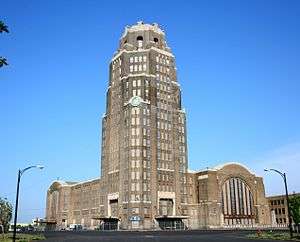 | |||||||||||||||||||||||||||||||||||||||||||||||||
| Location | 495 Paderewski Drive, Buffalo, New York | ||||||||||||||||||||||||||||||||||||||||||||||||
| Coordinates | 42°53′23″N 78°49′49″W | ||||||||||||||||||||||||||||||||||||||||||||||||
| Line(s) | Empire Corridor (Buffalo Terminal Subdivision) | ||||||||||||||||||||||||||||||||||||||||||||||||
| Platforms | 14 island platforms | ||||||||||||||||||||||||||||||||||||||||||||||||
| Tracks | formerly 28 | ||||||||||||||||||||||||||||||||||||||||||||||||
| Other information | |||||||||||||||||||||||||||||||||||||||||||||||||
| Station code | BUF (former) | ||||||||||||||||||||||||||||||||||||||||||||||||
| History | |||||||||||||||||||||||||||||||||||||||||||||||||
| Opened | June 22, 1929 | ||||||||||||||||||||||||||||||||||||||||||||||||
| Closed | October 28, 1979 | ||||||||||||||||||||||||||||||||||||||||||||||||
| Former services | |||||||||||||||||||||||||||||||||||||||||||||||||
| |||||||||||||||||||||||||||||||||||||||||||||||||
Buffalo Central Terminal | |||||||||||||||||||||||||||||||||||||||||||||||||
 | |||||||||||||||||||||||||||||||||||||||||||||||||
| Location | Buffalo, New York | ||||||||||||||||||||||||||||||||||||||||||||||||
| Coordinates | 42°53′23″N 78°49′49″W | ||||||||||||||||||||||||||||||||||||||||||||||||
| Area | Buffalo Broadway/Fillmore district | ||||||||||||||||||||||||||||||||||||||||||||||||
| Built | 1929 | ||||||||||||||||||||||||||||||||||||||||||||||||
| Architect | Fellheimer & Wagner[1] | ||||||||||||||||||||||||||||||||||||||||||||||||
| Architectural style | Art Deco[1] | ||||||||||||||||||||||||||||||||||||||||||||||||
| Website | www | ||||||||||||||||||||||||||||||||||||||||||||||||
| NRHP reference No. | 84002389[1] | ||||||||||||||||||||||||||||||||||||||||||||||||
| Added to NRHP | September 7, 1984 | ||||||||||||||||||||||||||||||||||||||||||||||||
Layout
The terminal is located about 2.5 miles (4.0 km) from downtown Buffalo, and consists of several structures, some of which are connected, while others were formerly interconnected.
Concourses
The main concourse is 225 feet (69 m) long, 66 feet (21 m) wide, and 58.5 feet (17.8 m) tall (63.5 feet [19.4 m] at the domed ends). The concourse included various rental spaces; a restaurant with a dining room, lunch room, and coffee shop; a Western Union telegraph office; and a soda fountain, along with standard station necessities. Off the concourse there is a streetcar lobby and waiting room. Curtiss Street runs directly below the concourse, but has been closed since the late 1980s for safety reasons. The concourse is currently owned by the Central Terminal Restoration Corporation.
The train concourse is 450 feet (140 m) long and includes 14 low-level platforms. Each platform is accessed by a staircase and a ramp. The train concourse is owned by Amtrak, with the land being owned by CSX. In 1982, the bridge which connected the train concourse and passenger platforms from the terminal and main concourse was demolished to allow passage of high freight cars on the Belt Line. The rest of the concourse remains.
Buildings
The office tower is 15 stories, excluding the main floor, and mezzanine. The 271-foot (83 m) building is owned by the Central Terminal Restoration Corporation.
The baggage building on Curtiss Street is owned by the Central Terminal Restoration Corporation. It is a five-story building immediately adjacent to the Main Concourse. The mail building along Curtiss Street is owned by the City of Buffalo. It is a two-story building adjacent to the Baggage Building.
The Railway Express Agency was the early forerunner of today's Federal Express and UPS. The building is located behind the Mail Building of the complex and is by far the most decayed building. Trains would pull directly into the building to proceed with the load/unloading of goods. This building is currently owned by the City of Buffalo, which has confirmed plans to demolish it.
Former buildings
Other buildings included a Pullman Company service building, an ice house, and a coach shop, all of which were torn down in 1966 to lower property taxes.
The first building built as part of the project was a cogeneration power station that provided heat and electricity to the complex, even during construction. It contained three 28-foot (8.5 m) coal boilers. The building's smokestack was dismantled in 1966 to save on taxes. The power plant itself lasted up until the mid-1980s, with its exact demise not known.
History
Planning and construction (1925–1929)
During the late 19th century, Buffalo had several railroad stations, and there were calls for a single union station. In 1889, a Union Station was proposed to be built on the site of the future Central Terminal, but it never happened.
The New York Central Railroad (NYC) had two stations in Buffalo in the early 20th century: the Exchange Street Station and the Terrace Station. Both of these downtown stations were old—Exchange Street dated to before the American Civil War—and were plagued with downtown congestion.[3]
NYC decided to build the new Buffalo Central Terminal 2.5 miles (4.0 km) to the east, in order to relieve both rail and grade crossing congestion and to be more conveniently located for trains not terminating in Buffalo. A roomier area would also ease the transfer of sleeping cars between trains. Furthermore, Buffalo was a quickly growing city at the time, and it was believed that before long Central Terminal's area would become closer to the center of a sprawling metropolis of 1.5 million people. The city was not so sure, but planning was well underway in 1924, despite the lack of an agreement at the time.
NYC finalized its decision to build the terminal in 1925, and site preparation began the following year. NYC President Patrick Crowley hired Alfred T. Fellheimer and Steward Wagner to build the actual station in 1927. The total cost of the project was $14 million. Prior to the building of the station, the site was bounded to the south by the New York Central main line, to the northwest by the NYC's West Shore Railroad, and to the east by the NYC's Junction Railroad. When the station was built, the West Shore was abandoned between the NYC main line and the Junction Railroad, being rerouted via the other two lines and the new station. The former West Shore right-of-way is now Memorial Drive.
A grand celebration attended by 2,200 invited guests on June 22, 1929, opened the station. Speakers included Henry Thornton and Frank X. Schwab. Although an eastbound Empire State Express departed the station at 2:10 PM, the train was not a regular one, and was really just ceremonial. The station did not open until the celebration ended at 3:30, and scheduled service began on June 23.
Opening
In the early days, the station was served not only by the owner, but also by the Canadian National Railway, Pennsylvania Railroad, and the Toronto, Hamilton & Buffalo Railway.
When the NYC operated the 20th Century Limited, Central Terminal was located approximately 44 miles (71 km) east of the half-way point from New York City to Chicago, and the trains would pass each other near there.
For most of Central Terminal's history, far too trains stopped there to justify the use of such a large facility. Although it started with 200 trains daily, the Great Depression began less than a year after its construction, and the rise in automobile use also hurt passenger levels.
Wartime and decline (1941–1979)

There was a burst of activity during World War II when the station had a reasonable amount of train traffic for its size. Notable trains making daily calls at the station include the Wolverine, Interstate Express, the Ohio State Limited, the Lake Shore Limited, the 20th Century Limited (engine crew-change stop only), the New England States, the Boston Express, the Empire State Express, Southwestern Limited, among many others.
After the war, the station entered into what would be a permanent decline, amid the larger decline in train travel across the country. As early as 1956, the New York Central offered the terminal for sale for one million dollars. A company called Buffprop Enterprises did negotiate a 25-year lease of the terminal in 1959, but it ended the following year. Service to Niagara Falls, New York, ended by 1961.
In 1966, the continuing decrease in passenger revenues caused NYC to demolish parts of the Terminal complex, including the Pullman service building, coach shop and ice house. In 1968, the NYC merged with the PRR to form Penn Central Transportation (PC), which operated the terminal until the creation of Amtrak in 1971.
The bankrupt PC was absorbed by Conrail in April 1976. In 1978, Amtrak restored direct service to Niagara Falls. One train per day connected with Via Rail Canada/Toronto, Hamilton and Buffalo Railway service to Toronto–forerunner of today's Maple Leaf. The financially strapped passenger carrier was in no position to rehabilitate Central Terminal, resulting in the reopening of Buffalo-Exchange Street station near downtown for the Empire Service route, including the connecting service to Toronto, further marginalizing use of Central Terminal. This left Central Terminal with only two routes–the Chicago-bound Lake Shore Limited and the Detroit-bound Niagara Rainbow. The four daily trains did not even begin to justify such a large station; Amtrak had to spend $150,000 per year on heating bills alone. Rather than spend the massive sums necessary to rehabilitate Central Terminal, Amtrak replaced it in 1979 with the much smaller Buffalo-Depew station, 10 miles east of downtown. The last train that called at Central Terminal was the westbound Lake Shore Limited, which departed at 4:10 am on October 28.[4]
Ownership by Anthony Fedele (1979–1986)
The building was sold to Anthony T. Fedele, a local builder, for $75,000 in 1979. Fedele planned a 150-room hotel, offices and restaurants for the terminal complex that would have been called Central Terminal Plaza but could not find investors for the project.[5] Fedele also lived in the building creating an apartment for himself in the tower on the second floor. While the building was under the control of Fedele it was reasonably taken care of.
It was during this time that the railroad tenant left. Conrail closed its Terminal general offices in 1980. The Conrail Dispatching Department was the last business to leave the Terminal in 1984. Two interlocking towers, numbered 48 and 49, that serviced the tracks on the property were shut down in 1985.
In November 1983, in a sign of things to come, the building was in danger of being sold out from under Anthony Fedele by the IRS for back taxes. Fedele made an attempt at settling the debt by paying $10,200 toward the $142,128 due, and agreed to pay $2000 a month until the debt was paid in full.[6] While he owned the building it was placed on the National Register of Historic Places on August 3, 1984.
Thomas Telesco ownership (1986–1997)
.jpg)
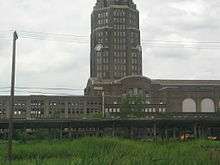
In 1986, Anthony Fedele defaulted on his taxes and US Bankruptcy Court Judge John W. Creahan ordered a foreclosure sale. The Buffalo Central Terminal was put up for auction and won by Thomas Telesco, the only bidder, for $100,000. Telesco talked about turning it into a banquet hall and using it as a station on a proposed high-speed rail line linking New York and Toronto. He later began the process of selling the architectural artifacts and other items of value from the building.
The building was then acquired by Bernie Tuchman and his uncle, Samuel Tuchman. This period was one of great decay for the Terminal. The Terminal's main buildings were subject to extensive artifact removal. Once a truck was being used to remove ceiling lights when it backed into the famous plaster bison statue in the concourse, smashing it. Artifacts removed and sold included iron railings, signs, lights and mailboxes. Further, the building was not secured, and vandalism was extensive, and even included some arson attempts. It is said that the only thing that saved the building was the fact that demolition would have been too expensive ($12 million).
Reacting to complaints and questions from preservationists in Buffalo, the owners responded, "If you think you could do a better job, I'll sell it to you for a dollar."
Central Terminal Restoration Corp. (1997–present)
Scott Field of the Preservation Coalition of Erie County[7] bought the building in August 1997 for the purchase price of $1 and assumption of approximately $70,000 in back taxes. Shortly afterward, the Central Terminal Restoration Corporation (CTRC) was formed and currently owns the Concourse, Tower and Baggage Building.[2]
The CTRC is a non-profit, volunteer organization whose goal is to preserve the Terminal and help promote it as a viable redevelopment opportunity in the City of Buffalo. The CTRC received money to restore and relight the exterior tower clocks located on the 10th floor, relighting them on October 1, 1999. Also in 1999, a state grant for $1 million was obtained to begin the process of sealing and protecting the complex. The top of the building was re-lit starting on May 11, 2001. In 2003, the building was re-opened for public tours.
Currently, the Buffalo Central Terminal is host to approximately forty major fundraising events each year. Work continues to progress and new areas of the building are cleaned up and reopened to the public each year. Since 2003 over 100,000 people have visited the building. This is more than the local Frank Lloyd Wright properties of Western New York have had. The building has been a host to tours, art shows, local political events, train shows, annual Dyngus Day and Oktoberfest, weddings, as well as a temporary art installation by controversial artist Spencer Tunick in 2004.
The clock in the center of the concourse, sold by earlier owners, was located in Chicago in 2003. In late 2004, the clock was purchased for $25,000 through fundraising organized by WBEN and a donation from M&T Bank. The clock was on display in the Terminal during the 2005 event season. In the fall of 2005, it was relocated to the lobby of M&T Center in downtown Buffalo, where it remained until spring of 2009. The clock was then moved back to its original location in the Terminal concourse where it will sit permanently on public display.
In November 2005, Red Scream Films LLC shot their first feature film Prison of the Psychotic Damned in the Terminal. The low budget film details what happens when a group of dysfunctional ghost-hunters decide to spend a night in the long rumored to be haunted structure. A benefit sneak-peek screening of the film with all proceeds going to the CTRC was held June 23, 2006, at 6pm. The film company returned to the Terminal in August to shoot part of their third feature FrightWorld
The paranormal investigators, The Atlantic Paranormal Society (TAPS), visited the terminal for about a week in June 2008 and aired their findings on Ghost Hunters (Episode 417 - "Speaking With the Dead"), September 24, 2008. Footage taken during this investigation shows that, aside from the main concourse, the entire complex is still currently in a state of heavy disrepair. The spin-off show Ghost Hunters Academy visited the terminal for the episode broadcast December 2, 2009. On October 31, 2010 (Halloween), Ghost Hunters aired a live 6-hour broadcast from the station.
In 2016 Toronto based developer Harry Stinson was named by the CTRC as the designated developer for Buffalo's Central Terminal to re-develop the Terminal complex.[8] Stinson's proposal included turning the Terminal into a mixed use facility and also included building townhouses in the surrounding neighborhood to create a village like atmosphere with proceeds being invested into terminal restoration.[9] The proposal also offered the possibility of restoring rail services to the terminal.[10]
On May 5, 2017, after numerous delays the CTRC cut ties with Stinson in favor of working with the Urban Land Institute on a new redevelopment plan.
In October 2017, the World Monuments Fund selected Central Terminal as part of its 2018 World Monument Watch List, one of two selections from the United States and one of 25 selections total.[11]
In 2018, two hundred solar panels were installed at the terminal restoring commercial grade electric to the facility.[12]
Future
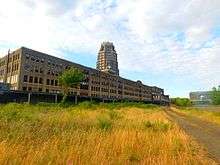
CTRC Master Plan
Multiple ideas and plans have been proposed for Central Terminal's future. A master plan was established in 2009 by the CTRC that entailed their vision for the future of the terminal.[13] In 2013 the CTRC announced the reuse plan for the terminal stating "Although much work needs to be done to stabilize and prepare the complex for tenancy and other use, various groups have toured the complex and have expressed interest in becoming anchor tenants or partner developers utilizing a Public/Private Development concept." Remedial measures and repairs, replacements and new technologies are part of the plan for the Center. Roof replacement is currently underway with an Energy Star compliant membrane being laid down and a solar Photovoltaic system being installed in the future. The Terminal is experiencing great in-kind development and services with local businesses and trade unions. Other immediate projects include restoration of the Guastavino Tile in the Main Concourse; Brownfields remediation plan and general utilities and improvements. The CTRC is looking forward to the additional historic restoration and remediation of all masonry and windows along with new systems for HVAC utilizing Green Technologies.

Although the project does not rely on it happening, it is the ultimately the CTRC's hope that, with the reuse of the Terminal, rail traffic will also be forthcoming whether starting with interest in the possible reuse of Buffalo's legendary Belt Line; local light rail expansion and the future of the Terminal's reuse as a connector hub for possible high-speed rail. The Central Terminal Restoration Corporation, in cooperation with local, state, and federal government representatives, are working to position the Terminal to be Buffalo's high-speed rail station as well as the potential return of Amtrak service.[14][15] Buffalo, New York is part of the Empire Corridor, one of only ten Federally designated high-speed rail corridors in the United States.
Future of Amtrak in Buffalo
In September 2016, the roof of the downtown Exchange Street Amtrak station collapsed. This led to calls for a new train station in Buffalo and a discussion of moving the stop back to the Central Terminal. Congressman Brian Higgins called for a study for a new train station to be done at both Central Terminal and a site at Canalside saying about the terminal "It may not have been possible 15 years ago, but restoration of the Central Terminal is possible in the new Buffalo." "In the enormous scale of that redevelopment project, it may be possible to carve out a small 'station-within-a-station' that would squarely and singularly focus on providing a highly functional train station to meet current and projected needs. This (the Central Terminal) location would allow the restoration of service to Chicago within the city limits, and it certainly merits a meaningful engineering review."[16] Higgins' call was later reinforced by Senator Charles Schumer.
On October 5, 2016, Congressman Higgins along with Buffalo Common Council Member David Franczyk toured the terminal with Mark A. Lewandowski, president of the CTRC. Higgins came out in support of the station at the terminal as part of a larger redevelopment plan.[17] A public campaign to bring Amtrak back to the Central Terminal was launched complete with a website and social media.
A plan to return Amtrak to the Central Terminal could possibly later add a long discussed NFTA Metro Rail extension from Downtown to the Buffalo Niagara International Airport which would include stops at the Central Terminal as well as the Walden Galleria.[18] This would connect the Central Terminal to the airport as well as to the heart of downtown. On April 17, 2017, a 17-member panel including Buffalo mayor Byron Brown approved by a margin of 10-4 approved a downtown replacement close to the existing Exchange Street station over the terminal in a decision seen as controversial.[19] The station site and the Central Terminal became part of a political debate with candidates running in the upcoming mayoral election against Brown promising a reversal of this decision if elected.[20]
Urban Land Institute study and state involvement
In May, 2017 the CTRC, City of Buffalo and New York State decided to have the Urban Land Institute study the terminal, neighborhood and uses for the Terminal and report their findings in hope of developing a plan. The Urban Land institute is the body responsible for the successful reuse of Buffalo's Richardson Olmsted Complex. The group's comprehensive study of the Terminal complex was fast-tracked, with a projected completion by June 30, 2017. The process included a panel of experts who will be in Buffalo for a week to conduct interviews and make a concluding presentation.[21] The panel concluded that a strategy needs to be developed with one of the first steps including creating a development plan for the East Side. ULI also suggested having a master plan for the building which includes breaking down the minimum cost of repairing and stabilizing each part of the former train station. Suggestions for use included having the concourse reopen to the public with a restored restaurant as a year round venue as well as beautifying the green space and creating a park. Looking longer term, 6 to 20 years, their suggestions included enhancing Fillmore Avenue and reusing vacant lots around the area.[22] No suggestions were made for the tower or baggage buildings.
On April 13, 2018, Governor Andrew Cuomo announced $5 million in funding for a restoration of the concourse along with the creation of a year-round event space in the concourse, waiting room areas and parking accessibility along with full capacity for catering and entertainment following the Urban Land Institute recommendations. The CTRC is also expected to transition to a professional staff.[23][24]
Timeline
- 1925: An increasing need for a new train terminal is being seen in Buffalo. The current terminals were very hard to navigate through and were becoming too old to use. Buffalo was also becoming known as a train city with hundreds of trains going in and out each day.
- 1925: The documents of the Buffalo Central Terminal are signed, allowing the Terminal to be located where it is today.
- 1926: Construction begins, track is laid, and Lindbergh (now Memorial) Drive was created.
- 1927: Construction begins on the 17 story office tower.
- 1928: Steel work is done the entire year, the last rivet was laid in December.
- June 22, 1929: Grand opening of Terminal, which brought out 2,200 people for the gala. The first train departed at 2:00 p.m. that day.
- 1940s: After a decline in use of trains, the number of people traveling on trains increases due to World War II.
- 1956: Owing to a decrease in train usage, the BCT is put up for sale for $1 million, which is about 1/14 of its original cost, and does not sell.
- 1961: The ICC allows the New York Central Railroad to discontinue service between Buffalo and Niagara Falls.
- 1966: The Pullman Service Building, Coach Shop, Ice House, and Power House are demolished to reduce costs.
- 1968: The New York Central Railroad and the Pennsylvania Railroad merge to form Penn Central, the new owners of the Terminal.
- 1970: Penn Central goes bankrupt.
- 1971: Amtrak created, and used the Terminal as its central Buffalo station.
- 1976: Penn Central RR, Lehigh Valley RR, Erie-Lackawanna RR, and Lehigh & Hudson River RR merge forming Conrail, the new owners of the Terminal.
- October 28, 1979: Amtrak abandons the Terminal on October 28, for the newer Dick Road station in Depew.[4]
- 1982: Train concourse bridge is demolished so taller freight cars can pass through the station on the "Belt Line".
- 1984: The Terminal is placed on the State and National Registers of Historical Places, therefore it is now unable to be torn down.
- 1985: Tony Fedele requests energy surveys from the NY State Energy Office for the remaining five buildings that were part of the Terminal.
- 1986: Fedele goes bankrupt and the Bankruptcy Court and Thomas Telesco wins it for $100,000, being the only bidder.
- 1986-1997: The Terminal faces a period of mostly neglect. The two owners during the period, Telesco and Tuchman pawn off most of the valuable items and vandals who can easily access the building destroy it. Weather also damages it, causing severe water damage to much of the concourse. A few arsons also occur.
- 1990: Complex sold to Bernie Tuchman.
- 1993: The concourse, owned by Amtrak, is leased for heavy equipment storage.
- 1997: The Buffalo Central Terminal Restoration Corporation buys the Terminal for $1, and about $70,000 in back taxes.
- 1999: $1 million of Erie County money was set aside to fix the tower. The clock was re-lit again October 1 of that year.
- 2000: A large snowstorm causes the city to dump loads of snow on the unstable property, and the Central Terminal Restoration Corporation (CTRC) sues the city for $1 million. The city decides to cancel the $70,000 the CTRC owes it for back taxes.
- 2003: The removal of 350 tons of debris, repairs, asbestos removal, roof work and the repair of 4000 windows. The Terminal is able to be opened for tours.
- November 2003: The BCT is put on the Preservation League of New York State's "Seven to Save" list.
- 2004: BCT turns 75 and has a big celebration. The city gives them $75,000 for rehabilitation of the building.
- May 2005: The original concourse clock, found for sale on eBay out of Chicago, was (with the help of M&T Bank, WBEN and many Buffalonians) saved, and the CTRC was able to purchase it.
- 2006: The Buffalo Central Terminal has 20,000 visitors, breaking a record, due to Oktoberfest, the Buffalo Brewfest, and the Train Show.
- 2007: CTRC celebrated 10th anniversary as the Dyngus Day celebration comes back to the Terminal.
- 2008: Two large projects are completed: abatement in the restaurant area and concrete work by the entrance.
- 2009: The Buffalo Central Terminal celebrates its 80th Anniversary in June and the Main Concourse Clock returns to the Terminal.
- 2011: Master plan outlining reuse of the complex released to public. CTRC awarded a $306,000 grant from New York State Office of Parks, Recreation, and Historic Preservation to repair and restore two of the original entryway canopies. A replica Buffalo statue is placed in the Main Concourse. Urban Habitat Project launched to transform a portion of the grounds. First public tours up to the third floor of the tower are held.
- 2012: With help from public donations, the CTRC acquires one of the Terminal's original light fixtures for $3,000 from a Toronto antique dealer. After raising the $3000, the dealer agrees to donate the fixture to the CTRC.
- 2013: CTRC begins phase 1 of the replacement of the roof over passenger waiting room. Replacement concourse light fixtures are made from the donated original light fixture by Sheet Metal Workers Union 71.
- 2016: Parts of the main concourse including the ticket areas, two union news stands and the main entrance were cosmetically restored by and as part of filming for the movie Marshall.
- 2017: $250,000 in electrical upgrades are secured.
- 2018: $5 million from the State of New York secured for restoration of the concourse, full capacity for catering and entertainment and professional CTRC staff.
- 2018: 200 solar panels restores commercial grade electricity.
Statuary
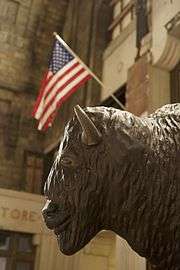
Several notable statues have graced the station's space over the years. The station once had a stuffed American bison in the concourse, belonging to the Buffalo Museum of Science and used to advertise the museum. Passengers (including soldiers bound for World War II) rubbing their hands on the bison caused it to become worn, so it was removed to the Buffalo Museum of Science and replaced with a plaster cast, bronze painted statue. This statue was accidentally destroyed by an owner during abandonment. A bronze recasting from the original molds can be found outside Alumni Arena at the University at Buffalo North Campus. On October 17, 2011 the buffalo in the terminal was replaced by the Central Terminal Restoration Corporation with one made out of fiberglass donated by Mollenberg-Betz, Inc., a Western New York-based mechanical contractor and Niagara Coatings Services, who specializes in various industrial coatings.
After the station was closed, the statue called "Progress" was placed on the terminal plaza by Anthony Fedele, who was the owner of the building after it closed down. The statue is said to have been of Madonna and Child. It was ruined when an attempt was made to move the statue to the Griffis Sculpture Park in East Otto, New York.
In popular culture
| Title | Date | Notes |
|---|---|---|
| Route 66 | December 13, 1963 (air date) | Seen in the cold open of the episode "Come Home Greta Inger Gruenschaffen" |
| Best Friends | 1982 (shooting date) | |
| Vamping | April 1983 (shooting date) | |
| The Natural | August 1983 (shooting date) | |
| Ghost Hunters | September 24, 2008 (air date) | |
| Ghost Hunters Academy | December 2, 2009 (air date) | |
| Ghost Hunters | October 31, 2010 (air date) | Live Halloween special |
| The Frail | Setting for the music video, which was filmed entirely on site and produced by Park School Media | |
| Off Limits | June 27, 2011 (air date) | |
| Battledogs | April 6, 2013 (release date) | |
| So Alive | April 8, 2016 (release date) | Setting for the Goo Goo Dolls' music video |
| Marshall | May & June, 2016 (shooting date)[25] | |
| Clover | April 2, 2020 (release date) |
Gallery
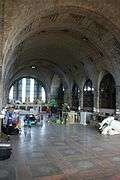 The main concourse
The main concourse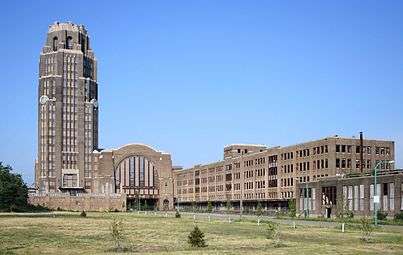 Buffalo Central Terminal
Buffalo Central Terminal One of four corner clocks on the office tower
One of four corner clocks on the office tower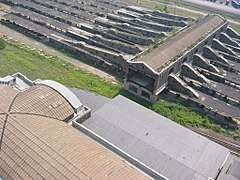 Seven platform train concourse accessed by stairs or a ramp. It is now detached from the main building.
Seven platform train concourse accessed by stairs or a ramp. It is now detached from the main building.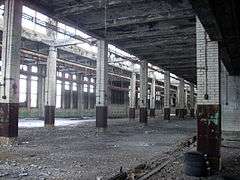 Interior of the Mail Building on the Central Terminal grounds.
Interior of the Mail Building on the Central Terminal grounds.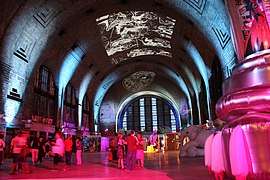 Artists and Models fundraiser event in the main concourse, 2007
Artists and Models fundraiser event in the main concourse, 2007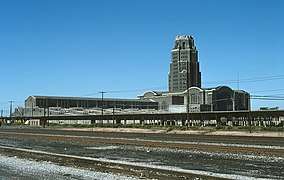 NYC Central Terminal, Buffalo, NY, October 1987
NYC Central Terminal, Buffalo, NY, October 1987
See also
- List of tallest buildings in Buffalo
- Tower City Center – Formerly the Cleveland Union Terminal, a similar train station-turned-entertainment center
- Buffalo–Exchange Street station
References
- "National Register of Historical Places - New York (NY), Erie County". National Register of Historic Places. National Park Service. February 22, 2007.
- "Dedicated to the restoration of the New York Central train station in Buffalo, NY". Buffalo Central Terminal. April 18, 2013. Archived from the original on September 9, 2013. Retrieved September 1, 2013.
- "National Register of Historic Places Inventory--Nomination Form" (PDF).
- "New Buffalo Station". Amtrak NEWS. 6 (12): 6–7. November 1979. Retrieved August 9, 2013.
- "Station Has Seen Last Train but Not Last Chance". New York Times. October 14, 1992.
- "decline and abandonement [sic]". The New York Central Terminal of Buffalo, New York. Archived from the original on 2012-04-04. Retrieved 2016-11-24.
- "Archived copy". Archived from the original on December 5, 2006. Retrieved November 19, 2006.CS1 maint: archived copy as title (link)
- "Buffalo's Central Terminal Restoration Corporation names Stinson Developments as designated developer". us.geosnews.com. June 11, 2016.
- "Master plan for Buffalo's Central Terminal includes townhouses". The Buffalo News. May 24, 2016. Retrieved August 7, 2016.
- "Terminal City". Buffalo Rising. September 12, 2016.
- "Buffalo's Central Terminal Selected for 2018 World Monument Watch List". Buffalo Rising. 2017-10-16. Retrieved 2017-10-19.
- "Central Terminal progress, plans to be discussed at meeting". The Buffalo News. 2018-11-01. Retrieved 2018-11-06.
- "Master Plan Overview". Buffalo Central Terminal. Archived from the original on September 1, 2013. Retrieved September 1, 2013.
- "is Right for High Speed Rail". Buffalo Central Terminal. Archived from the original on March 14, 2014. Retrieved September 1, 2013.
- "High Speed Rail". Buffalo Central Terminal. Archived from the original on March 14, 2014. Retrieved September 1, 2013.
- Sommer, Mark (September 26, 2010). "Higgins wants study of Canalside, Central Terminal for new train station". The Buffalo News.
- McKinley, Dave (October 6, 2016). "Passenger Trains at Buffalo Central Terminal?". WGRZ.
- Reilly, Ed (September 30, 2015). "Will Metro Rail extend to airport in Cheektowaga?". WKBW.
- "Downtown Buffalo recommended for train station".
- "Buffalo Train Station Still Dividing WNY Leaders". www.nystateofpolitics.com.
- "Developer dropped from Central Terminal project says he was 'blindsided'". 5 May 2017.
- Ingersoll, Ali (30 June 2017). "ULI group releases report, strategy for Central Terminal".
- "Big Deal: State to Provide $5 Million Toward Central Terminal Work". Buffalo Rising. 2018-04-13. Retrieved 2018-04-13.
- "Central Terminal to receive $5 million state grant for concourse, staffing". The Buffalo News. 2018-04-13. Retrieved 2018-04-13.
- Hsieh, Cresonia (June 25, 2016). "Central Terminal is given a temporary face-lift, thanks to "Marshall" crew". The Buffalo News. Archived from the original on June 27, 2016. Retrieved June 26, 2016.
External links
| Wikimedia Commons has media related to Buffalo Central Terminal. |
- Official website
- Buffalo Central Terminal on Opacity.com
